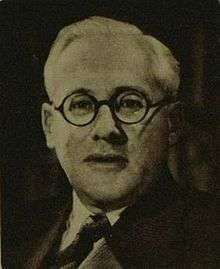Alan Sainsbury, Baron Sainsbury
Alan John Sainsbury, Baron Sainsbury (13 August 1902 – 21 October 1998) was a British business executive and a leading member of the supermarket Sainsbury family.
The Lord Sainsbury | |
|---|---|
 | |
| Born | Alan John Sainsbury 13 August 1902 |
| Died | 21 October 1998 (aged 96) |
| Known for | businessman, politician and peer |
| Net worth | £1.3 billion[1] |
| Political party | Liberal, Labour, SDP |
| Parent(s) | John Benjamin Sainsbury |
| Relatives | Robert Sainsbury (brother) |
Early and private life
His grandparents, John James Sainsbury and Mary Ann Staples, established a grocer's at 173 Drury Lane in 1869 which became the British supermarket chain Sainsbury's. He and his wife Doreen with whom he married in 1925 had three sons:
He later remarried in 1944 and had a daughter Paulette.
As he was divorced, he spent little time with his sons John Davan, Simon and Timothy, and so they only got to know their father when they joined the family firm.
On 3 May 1962 he was the first of three members of the Sainsbury family to receive a life peerage. He took the title Baron Sainsbury, of Drury Lane in the Borough of Holborn.[2] As the first peerage using the family name, the territorial designation – referencing the location of the family's first shop – did not form part of the title. When Alan's son John became a peer in 1989, he took the title Baron Sainsbury of Preston Candover to differentiate between them. In the same way when Alan's nephew David was ennobled in 1997 he was made Baron Sainsbury of Turville.
Business career
Educated at Haileybury College, Alan joined Sainsbury's in 1921 aged 17, the same year his youngest uncle, Paul Sainsbury, joined the family firm. He began his career working alongside his uncles as a buyer. He became a director of the Company, then known as J. Sainsbury Ltd., in 1933 and became joint managing director of Sainsbury's with his brother Robert Sainsbury in 1938 after his father, John Benjamin Sainsbury (the eldest son of Sainsbury's founder John James Sainsbury), had a minor heart attack.
Alan Sainsbury was instrumental in bringing the self-service supermarket to Britain and shaping many of the conditions by which we shop for food today. On a trip to America he saw the experience of self-service supermarkets, and John James Sainsbury's show-piece Croydon branch of Sainsbury's was converted to self-service in 1950. On handing out wire baskets on opening day, one customer was so annoyed, she threw a basket in Alan Sainsbury's face, and one member of staff refused to be an assistant in a self-service supermarket.
In 1956, he became chairman after the death of his father, John Benjamin Sainsbury.
The original shop at 173 Drury Lane closed in 1958. The Manager Mr Pawsey handed Alan Sainsbury the key, saying, 'Your grandfather opened this shop, and I think it's only right that you should close it'.
Alan Sainsbury also pioneered fresh and frozen foods, and increased Sainsbury's own label range. He introduced oven-ready frozen chickens and the simple but powerful slogan "Good Food Costs Less at Sainsbury's" in 1959. Sainsbury's also released its first public relations video in 1964.
He retired as chairman in 1967 to be replaced by his brother Robert, and became Life President. On Sir Robert's retirement in 1969, at which point his son John Davan Sainsbury became chairman, Sir Robert was appointed Joint Life President of the retailer.
By this time Sainsbury's boasted 244 UK grocery stores (162 self-service shops and 82 counter service stores). The average size of new supermarkets was 8,120 sq ft (754 m2). The range of products increased from 350 to 4,000 (including 1,500 own brand products).
In 1969 sales reached £166m and profit before tax was £4.3m. The Company also boasted the highest sales per square foot in the food retailing industry and the market share of the UK supermarket business was 2.5%, turning Sainsbury's into a medium-sized, regional business in London and the South-East.
When the company listed on to the London Stock Exchange on 12 July 1973, as J Sainsbury plc, which was at the time the largest flotation ever, his family at the time retained control with an 85% stake. Alan Sainsbury split his 18% stake in the business between his sons John Davan Sainsbury, Simon Sainsbury and Tim Sainsbury, and so they held 6% each. Meanwhile, his brother Sir Robert Sainsbury gave his entire 18% stake to his only son David Sainsbury. It is believed that Sir Robert Sainsbury gave David Sainsbury his entire shareholding (rather than split it between David and his three daughters) so that David would have more votes at the table, considering John Davan Sainsbury, who became chairman in 1969 on Sir Robert Sainsbury's retirement, had a forceful, autocratic style of leadership, whereas David was always more cautious (and always seemed less interested in the family business than John Davan (David having only joined Sainsbury's personnel department as he did not get the grades to become a scientist)).
Alan and Robert's sons John and David both chaired the family firm and were later awarded life peerages.
Political career
Alan Sainsbury also stood as a Liberal parliamentary candidate at Sudbury in the 1929, 1931 and 1935 general elections, before joining the Labour Party in 1945. In 1981, he was one of 100 prominent supporters of the "Gang of Four" who broke away from Labour to form the SDP.
References
- "Lord Sainsbury and family". Sunday Times Rich List 2008. London. 27 April 2008. Retrieved 20 April 2009.
- "No. 42665". The London Gazette. 4 May 1962. p. 3585.